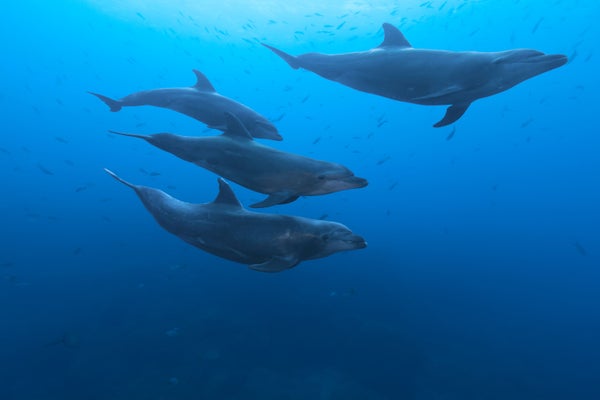Imagine standing in a pitch-dark parking lot at midnight, trying to unlock your car. You drop your keys and, unable to see, you squat down and feel around for them. Your hand brushes against a tire, then jagged pebbles, and finally, you grasp the familiar shape of a key. This tactile exploration may be the closest analogy to the experience of dolphin echolocation, according to a new study published in PLOS ONE.
Echolocation is often described as “seeing” with sound, where auditory signals create a world of images. Like sonar, echolocators emit sounds and decode the echoes that return, forming spatial and textural information. However, new research suggests that for dolphins, this process might be more akin to “touching” with sound, challenging previous notions that linked echolocation to visual processing.
Revisiting the Science of Echolocation
In the 1970s and 1980s, Russian scientists inserted electrodes into the brains of dolphins and porpoises, detecting activity in the visual cortex when the animals heard sounds. This supported the idea that echolocation involved visual processing. However, Lori Marino, a neuroscientist and president of the Whale Sanctuary Project, notes that advancements in technology are shifting this perspective. “The whole research landscape is changing,” she says.
The recent study compared the brains of three echolocating dolphin species with that of a sei whale, a non-echolocating relative. By measuring the diffusion of water molecules along nerve fibers, researchers aimed to understand brain interactions in living dolphins. Contrary to earlier findings, the visual cortex showed no exceptional activity. Instead, the neural connection between the inferior colliculus and the cerebellum stood out.
The Role of the Cerebellum
In both dolphins and humans, the inferior colliculus serves as a relay for auditory input, while the cerebellum integrates sensory information to facilitate rapid decision-making. “Anytime you need to move quickly and decisively, your cerebellum comes alive,” explains Peter Cook, a comparative neuroscientist at the New College of Florida and senior author of the study. The strong connection between these brain regions in dolphins, absent in the sei whale, suggests that echolocation relies heavily on the cerebellum’s motor control rather than the visual cortex.
“Every time you move, you get different feedback,” Cook says. “And every time the feedback changes, you change how you’re moving. It’s like this constant circle of sensory, motor, motor, sensory.”
Sophie Flem, the study’s lead author and a master’s student at the New College of Florida, supports this view. “If you need to constantly fine-tune your movements to home in on prey, it does seem intuitive that something like a cerebellum would really help,” she notes.
Echolocation: A Narrow Beam of Perception
Another aspect that aligns echolocation with touch rather than vision is the narrowness of a dolphin’s sonar beam. Unlike humans, who can take in a 180-degree visual field at a glance, dolphins must move their sonar beam to build a spatial understanding gradually, akin to a person feeling around for dropped keys in the dark.
Despite these insights, Marino cautions against assuming we fully understand animal echolocation. “There may be things other animals do for which there is no model in our sensory system,” she says. “We just have to realize that.”
Implications and Future Research
This study opens new avenues for understanding how different species perceive their environments. By focusing on the cerebellum’s role in echolocation, researchers can explore how other animals might use similar mechanisms for navigation and hunting. Future research could further unravel the complexities of sensory processing in dolphins and other echolocating species.
As scientists continue to explore these neural pathways, the findings may not only enhance our comprehension of animal behavior but also inspire technological advancements in sonar and sensory equipment. The ongoing study of echolocation underscores the intricate and diverse ways in which life on Earth has evolved to interact with the world.
